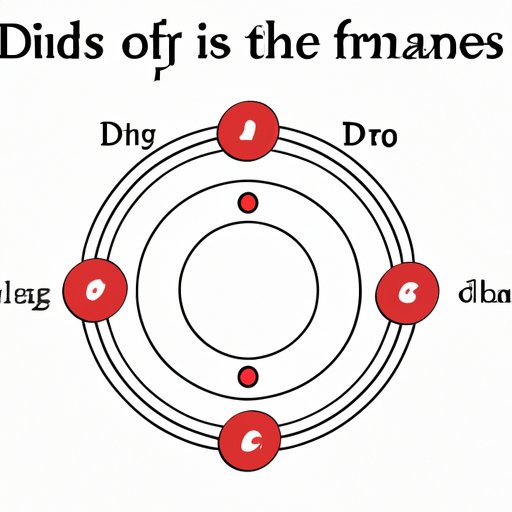
I. Introduction
Circle diameter is a fundamental measurement used in different fields such as engineering, mathematics, and science. Knowing the diameter of a circle is essential when calculating its area or circumference, finding the size of a circular object, or designing circular structures. In this article, we’ll cover everything you need to know about finding the diameter of a circle. From simple formulas to more complex techniques, we’ll explore the different ways to calculate circle diameter and provide tips to ensure accuracy along the way.
II. Back to Basics: Simple Steps to Find the Diameter of a Circle
The diameter of a circle is the distance across its widest point, passing through the center of the circle. It’s represented by the symbol “d,” and it’s an essential measurement for various calculations. The diameter is crucial when determining the circumference of a circle, which is the distance around the outside of the circle.
The formula for finding the diameter of a circle is straightforward: diameter equals twice the radius of the circle (d = 2r). The radius is the distance from the center of the circle to any point on the circle’s circumference. Therefore, if you know the radius of a circle, you can quickly determine its diameter by multiplying the radius by two.

III. The Math of Circles: An Easy Guide to Finding Diameter
The diameter is closely related to other circle measurements such as the radius and circumference. Knowing these relationships can help you calculate the diameter using alternate methods, providing additional flexibility in your calculations.
One common relationship is between the diameter and circumference of a circle. If you know the circumference of a circle, you can find its diameter by dividing the circumference by pi (π). The formula is d = C/π, where C is the circumference of the circle. This relationship provides a more practical method for finding the diameter, especially if you only have the circumference measurement on hand.
IV. Unlocking the Mystery of Circle Diameter: Tips and Tricks
When finding the diameter of a circle, it’s essential to avoid common mistakes that could lead to inaccurate results. These mistakes include incorrect use of radius or circumference formulas or confusing diameter with other circle measurements.
Visual aids or diagrams can be helpful when understanding circle measurements, including diameter. For example, a compass or a protractor can be used to draw a circle with accurately measured radius or diameter. You can also create a sketch or diagram of a circle to assist with your measurements and calculations, particularly when dealing with real-life scenarios or complex circular structures.
Knowing when to find circle diameter is also crucial. For instance, when designing or creating circular objects or structures, it’s essential to have accurate measurements to avoid errors or safety hazards. It’s also important to have precise measurements when calculating the area or circumference of a circle.
V. From Circumference to Diameter: Mastering Circle Measurements
The formula d = C/π is one method of finding the diameter when only the circumference measurement is available. To use this formula, you need to measure the circumference of the circle accurately. Once you have the circumference measurement, divide it by the constant pi (π) to obtain the circle’s diameter. For example, if the circumference of a circle is 50cm, you can calculate its diameter as follows:
d = C/π = 50/π ≈ 15.92cm
Therefore, the diameter of the circle is approximately 15.92cm.
VI. Discovering Circle Diameter: A Step-by-Step Approach
If you have the radius measurement of a circle, you can find its diameter using the formula d = 2r. The radius is half of the diameter, so multiplying the radius by 2 gives you the diameter. For example, if the radius of a circle is 8cm, its diameter can be calculated as follows:
d = 2r = 2(8) = 16cm
Therefore, the diameter of the circle is 16cm.
VII. The Ultimate Guide to Calculating Circle Diameter
We’ve covered various methods of finding the diameter of a circle, including using the radius or circumference formula and understanding the relationship between diameter, radius, and circumference. Depending on the available information and purpose of the calculation, some methods may be more suitable for specific scenarios.
For example, if you only have the circumference measurement, you can use the formula d = C/π. Conversely, if you only have the radius measurement, you can use the formula d = 2r. For more complex calculations or real-life scenarios, creating a diagram or sketch of the circle may be helpful. No matter the method used, it’s essential to avoid common mistakes and ensure accurate measurements.
VIII. Get to the Point: Efficient Methods to Find Circle Diameter
Finding the diameter of a circle is a crucial measurement that can be used in various fields. Whether you’re in science, engineering, or mathematics, knowing the diameter is essential for proper calculations and accurate design. By understanding the relationships between diameter, radius, and circumference and avoiding common mistakes, finding the diameter of a circle can be straightforward and efficient.
When calculating the diameter, it’s always recommended to double-check your measurements and methods to ensure accuracy. Creating a diagram or sketch of the circle can be helpful when dealing with real-life scenarios or complex circular structures. By mastering the different methods of calculating circle diameter, you can become confident in your calculations and pave the way for successful results.
Summary
In this article, we explored the importance of finding circle diameter, including its relationship with radius and circumference. We provided step-by-step guides and formulas for finding the diameter, with tips and tricks to ensure accuracy. We also discussed common mistakes to avoid and real-life scenarios where knowing circle diameter is essential. By mastering the different methods of calculating circle diameter, you can become confident in your calculations and pave the way for successful results.





